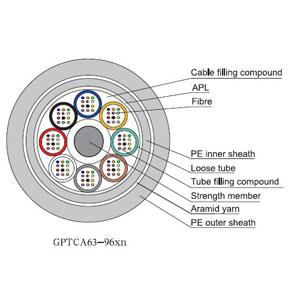-

- Sopto Home
-

- Special Topic
-

- Fiber Optics knowledge
-

- What is Loose Tube Fiber Optic Cable
Fiber Optics knowledge
- Maintained Methods of Fusion Splicer Parts
- How to Use the Fiber Optic Cleaver?
- What are Fixed Attenuators & Variable Attenuators?
- Deployable Fiber Optic Systems for Harsh Mining Environments
- Developing Miniature Fiber Optic Cable Has Become the Trend
- Fiber Optic Cleaning Procedures
- 6 Steps to Selecting a Fiber Optic Cable
- Signal Attenuation Introduction
- How Fiber Transmission Works?
SOPTO Special Topic
Certificate



Guarantee
Except products belongs to Bargain Shop section, all products are warranted by SOPTO only to purchasers for resale or for use in business or original equipment manufacturer, against defects in workmanship or materials under normal use (consumables, normal tear and wear excluded) for one year after date of purchase from SOPTO, unless otherwise stated...
Return Policies
Defective products will be accepted for exchange, at our discretion, within 14 days from receipt. Buyer might be requested to return the defective products to SOPTO for verification or authorized service location, as SOPTO designated, shipping costs prepaid. .....
Applications
Fiber Optis can be used in so many fields:
Data Storage Equipment
Interconnects,Networking
Gigabit Ethernet
FTTx, HDTV,CATV
Aerospace & Avionics
Data Transfer Tests
Network Equipment
Broadcast Automotive
Electronics,Sensing
Oil & Gas, Imaging
Outside Plant,Central Office
Harsh Environment
Data Transmission
Illumination,Institutions
Ship to Shore,Education
Simulation,Military,Space
Unmanned Aerial Vehicles
Semiconductor Equipment
Diagnostics & Troubleshooting
Premise Networks Carrier Networks
Independent Telecommunication Providers
SOPTO Products
- Fiber Optic Transceiver Module
- High Speed Cable
- Fiber Optical Cable
- Fiber Optical Patch Cords
- Splitter CWDM DWDM
- PON Solution
- FTTH Box ODF Closure
- PCI-E Network Card
- Network Cables
- Fiber Optical Adapter
- Fiber Optical Attenuator
- Fiber Media Converter
- PDH Multiplexers
- Protocol Converter
- Digital Video Multiplexer
- Fiber Optical Tools
- Compatible
Performance Feature
Fiber Optics knowledge
Recommended


What is Loose Tube Fiber Optic Cable?
Loose tube cable: small, thin plastic tubes containing as many as a dozen 250 micron buffered fibers used to protect fibers in cables rated for outside plant use. They allow the fibers to be isolated from high pulling tension and can be filled with water-blocking materials to prevent moisture entry. Loose tube cables are the most widely used cables for outside plant trunks because it offers the best protection for the fibers under high pulling tensions and can be easily protected from moisture with water-blocking gel or tapes.
These cables are composed of several fibers together inside a small plastic tube, which are in turn wound around a central strength member, surrounded by aramid strength members and jacketed, providing a small, high fiber count cable. This type of cable is ideal for outside plant trunking applications, as it can be made with the loose tubes filled with gel or water absorbent powder to prevent harm to the fibers from water.

It can be used in conduits, strung overhead or buried directly into the ground. Some outdoor cables may have double jackets with a metallic armor between them to protect from chewing by rodents or kevlar for strength to allow pulling by the jackets.
Since the fibers have only a thin buffer coating, they must be carefully handled and protected to prevent damage. Loose tube cables with single mode fibers are generally terminated by spicing pigtails onto the fibers and protecting them in a splice closure. Multimode loose tube cables can be terminated directly by installing a breakout kit, also called a furcation or fan-out kit, which sleeves each fiber for protection.
Loose tube materials for loose tube cables need to possess a relatively high modulus and good process ability. During manufacture, optical fiber is fed into the loose tube at a faster rate than it is being produced so that the optical fiber is laid helically within the tube. To buffer the fibers from each other and from any perturbations on the tube walls, the loose tube is filled with a gel compound similar in composition to the water blocking gels in conventional telecommunication cables. The loose tube material must therefore be compatible with the gel as in conventional cable insulation.
Structure of a Loose Tube Fiber Optic Cable Elements in a loose tube fiber optic cable:
1. Multiple 250um coated bare fibers (in loose tube)
2. One or more loose tubes holding 250um bare fibers. Loose tubes strand around the central strength member.
3. Moisture blocking gel in each loose tube for water blocking and protection of 250um fibers
4. Central strength member (in the center of the cable and is stranded around by loose tubes)
5. Aramid Yarn as strength member
6. Ripcord (for easy removal of outer jacket)
7. Outer jacket (Polyethylene is most common for outdoor cables because of its moisture resistant, abrasion resistant and stable over wide temperature range characteristics.)
For purchasing high quality fiber optic cables with low cost or for more products’ information, please contact a Sopto representative by calling 86-755-36946668, or by sending an email to info@sopto.com.





-180x180.JPG)
